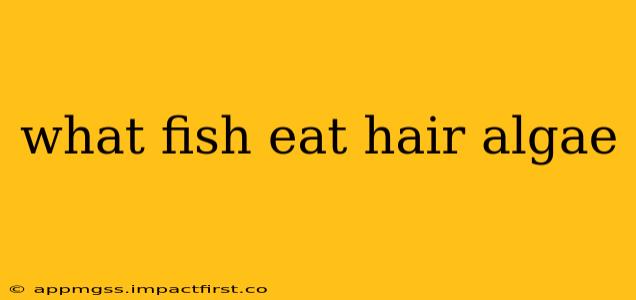Hair algae, those pesky stringy green strands that can quickly take over an aquarium, are a common frustration for fish keepers. Luckily, several fish species actively graze on hair algae, providing a natural and effective method of controlling its growth. Choosing the right fish depends on the size of your tank and the other inhabitants, but with a little research, you can find the perfect algae-eating companions for your aquatic ecosystem.
What Types of Fish Eat Hair Algae?
Many fish species will nibble on hair algae opportunistically, but some are particularly effective at keeping it under control. Here are some popular choices:
Top Tier Algae Eaters:
-
Siamese Algae Eaters (SAE): These are considered by many to be the most effective hair algae control fish. They are dedicated algae eaters, spending a significant portion of their time grazing on algae. However, they can be picky eaters as they age and may not touch other types of algae.
-
Otocinclus Catfish (Oto): These small, peaceful catfish are excellent at cleaning algae, including hair algae, from various surfaces within the tank. They are also relatively low-maintenance and peaceful, making them suitable for community tanks. However, they require specific water parameters and a diet that includes algae wafers or similar supplements to prevent starvation.
Good Secondary Options (May not fully control, but will help):
-
Nerite Snails: While not fish, these snails are incredibly effective at controlling various types of algae, including hair algae. They are peaceful, low-maintenance, and won't breed in freshwater aquariums.
-
Amano Shrimp: Similar to snails, Amano shrimp are excellent algae scavengers. They are efficient at consuming hair algae and won't overpopulate like some other shrimp species.
-
Certain species of Plecostomus (Plecos): While some Plecos are notorious for growing very large and becoming aggressive, smaller species can contribute to hair algae control. However, it's important to research the adult size of any Pleco you consider to ensure it's suitable for your tank.
How Many Algae-Eating Fish Should I Add?
The number of algae-eating fish you need depends on the size of your tank and the amount of hair algae present. It's generally better to start with fewer fish and add more if necessary, rather than overstocking the tank. Overstocking can lead to increased waste, impacting water quality and potentially harming your fish. A good rule of thumb is to start with one or two algae-eating fish per 10 gallons of water, adjusting as needed based on observation.
What if my fish aren't eating the algae?
Several factors can influence whether your fish actively eat hair algae. Here are some things to consider:
- Sufficient Algae: Is there enough hair algae to support the fish’s dietary needs? If algae is sparse, the fish may not consider it a priority.
- Dietary Variety: Algae-eating fish might ignore hair algae if offered other food sources. However, providing variety doesn't exclude the algae; fish will likely sample what's on hand.
- Water Parameters: Inadequate water quality can affect fish health and appetite, reducing their inclination to consume algae. Ensure water conditions are appropriate for the species.
- Fish Health: If your fish are unwell or stressed, they might not be interested in algae.
What other methods can I use to control hair algae?
While algae-eating fish are a great natural solution, combining them with other methods can significantly improve algae control:
- Regular water changes: Removing excess nutrients helps prevent algae growth.
- Proper lighting: Reduce excessive lighting which can fuel algae growth.
- Regular tank maintenance: Removing algae manually helps manage its spread.
- Balanced fertilization: An imbalanced nutrient level can also favor algae growth.
By carefully selecting the right algae-eating fish and employing complementary techniques, you can effectively maintain a clean and healthy aquarium, free from the nuisance of unwanted hair algae. Remember to always research the specific needs of any fish you introduce to ensure their well-being and compatibility with your existing aquatic community.
